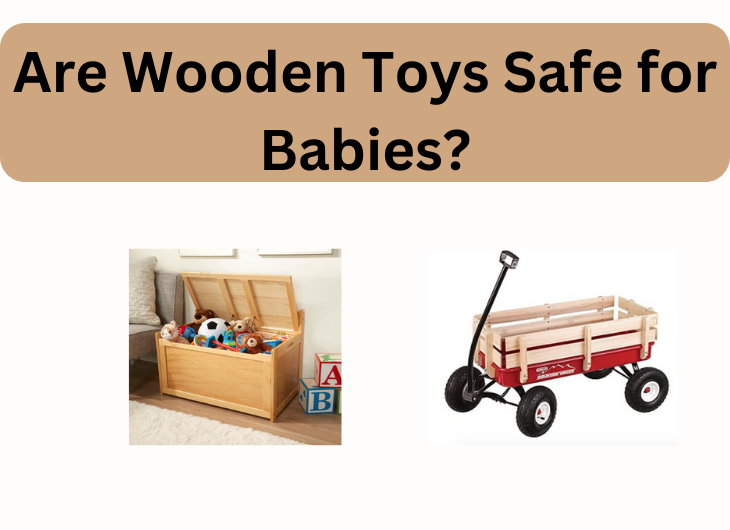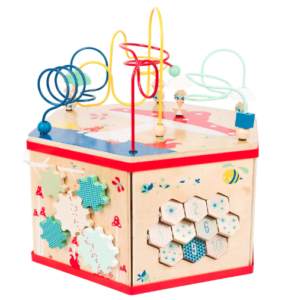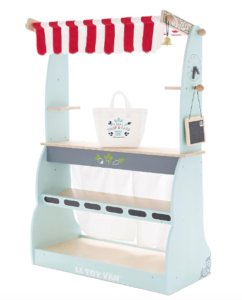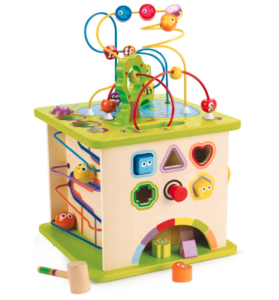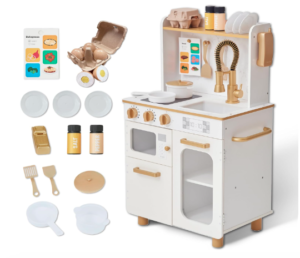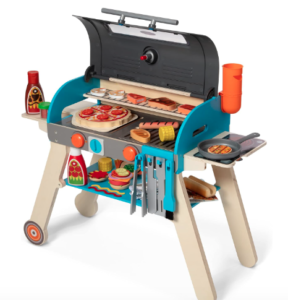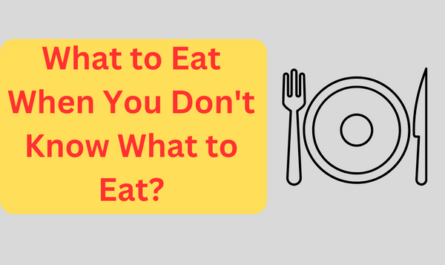Are Wooden Toys Safe for Babies?
Yes, wooden toys can be safe for babies when they are made from high-quality, non-toxic materials and designed with safety in mind. Here are some considerations to ensure the safety of wooden toys for babies:
Material Quality: Ensure that the wooden toy is made from high-quality, natural wood that has been properly finished and does not contain harmful chemicals or toxins. Look for toys that are certified to meet safety standards.
Smooth Surfaces: Wooden toys should have smooth surfaces and edges to prevent splinters or injuries. Any rough or sharp edges should be carefully sanded down.
Non-Toxic Paints or Finishes: If the wooden toy is painted or finished, make sure the paint or finish used is non-toxic and free from lead or other harmful substances.
Securely Attached Parts: Check that all parts and components of the toy are securely attached and cannot be easily detached, especially small parts that could pose a choking hazard.
Proper Size: Choose wooden toys that are an appropriate size for your baby to prevent choking hazards. Avoid toys with small pieces that can fit into a baby’s mouth.
Age-Appropriate Toys: Select wooden toys that are appropriate for your baby’s age and developmental stage. Age recommendations are typically provided by the manufacturer to guide you in choosing suitable toys.
Are wooden toys good for babies teething?
Yes, wooden toys can be a good choice for babies who are teething. The natural hardness and texture of wood can provide a soothing and satisfying sensation for a teething baby’s sore gums. Here are some reasons why wooden toys can be beneficial during the teething stage:
Natural Material: Wood is a natural material and is often free from harmful chemicals or toxins, making it a safe choice for babies to chew on.
Hardness and Texture: The hardness of wood can offer relief to a teething baby’s gums by providing a firm surface to chew on. The texture can also provide a pleasing sensation during the teething process.
Cooling Effect: Wood can maintain a cool temperature, which can be soothing for teething gums. Some wooden toys may be stored in the refrigerator for an additional cooling effect.
Non-Porous Surface: Unlike some other materials, wood generally does not harbor bacteria, making it a hygienic choice for teething toys.
Natural Sensory Stimulation: The natural colors, patterns, and textures of wood can stimulate a baby’s senses and contribute to their sensory development.
At what age can babies play with wooden toys?
Babies can begin to play with wooden toys as early as they start showing an interest in grasping and exploring objects, typically around 4 to 6 months of age. However, the exact age at which a baby can play with wooden toys can vary depending on their individual development and motor skills.
Here’s a general guideline for when babies can start playing with wooden toys at different stages of development:
0-6 Months: At this stage, babies are beginning to develop their grasp reflex and hand-eye coordination. Simple wooden toys, such as wooden rattles or grasping toys with smooth, rounded edges, can be introduced during this time.
6-12 Months: As babies reach 6 months and beyond, they are usually able to sit up and have better control of their hands. Wooden toys like blocks, wooden teethers, and wooden stacking toys can be introduced to encourage exploration and manipulation.
12-18 Months: At this age, babies are becoming more mobile and may start to walk. Wooden push-or-pull toys, shape sorters, and more complex stacking toys can engage their developing motor skills and problem-solving abilities.
18+ Months: Toddlers at this age can handle more intricate wooden toys, such as puzzles, dolls, playsets, and other toys that encourage imaginative play and creativity.
Always choose wooden toys that are age-appropriate, free from small parts that could pose a choking hazard, and have been designed with safety in mind. Supervision is crucial, especially for younger infants, to ensure safe play and prevent any potential accidents.
What kind of toys should not be given to babies?
Here are some examples of toys that should be avoided or used with caution for babies:
Small Toys or Parts: Avoid giving babies toys with small parts or pieces that can be a choking hazard. Babies often explore objects by putting them in their mouths, and small parts can easily be swallowed or cause choking.
Toys with Sharp Edges or Points: Toys with sharp edges or points can pose a risk of injury to a baby. Ensure all toys have smooth, rounded edges to prevent cuts or scratches.
Toys with Long Strings or Cords: Toys with long strings, cords, or ribbons can be a strangulation risk. Avoid toys that have strings longer than 6 inches or ones that could potentially wrap around a baby’s neck.
Toys with Toxic Materials: Steer clear of toys made from materials that could be toxic, such as certain plastics or materials containing harmful chemicals like lead or phthalates. Always opt for toys made from non-toxic and safe materials.
Toys with Fragile or Breakable Parts: Toys that are easily breakable or have fragile parts can present a risk of injury if they shatter or splinter.
Toys with Holes Smaller than a Baby’s Finger: Avoid toys with holes that are smaller than a baby’s finger to prevent trapping fingers and causing injury.
What kind of wood is safe for baby toys?
When considering wooden toys for babies, it’s important to choose safe and non-toxic wood. Here are some commonly used safe woods for baby toys:
Maple: Maple wood is a popular choice for baby toys because it is hard and durable, yet smooth and easy to work with. It is generally considered safe and non-toxic.
Beech: Beech wood is another commonly used wood for baby toys. It is hard, dense, and non-toxic, making it a suitable choice for teething toys and other baby items.
Ash: Ash wood is tough and can withstand wear and tear. It is typically considered safe for baby toys, but it’s essential to ensure it is untreated and free from harmful finishes or chemicals.
Cherry: Cherry wood is smooth, attractive, and considered safe for use in baby toys. However, make sure it is untreated and does not contain any harmful chemicals.
Birch: Birchwood is often used in baby toys because it is a durable and non-toxic hardwood. It has a fine grain and smooth surface, making it safe for babies to handle.
Rubber wood: Rubber wood, also known as Para wood, is a sustainable and eco-friendly option. It is safe, durable, and often used in baby furniture and toys.
Poplar: Poplar is a lightweight hardwood that is safe for baby toys. It’s important to ensure that it is untreated and free from any harmful substances.
What are some of the best wooden toys for kids?
Wooden toys are known for their durability, safety, and ability to encourage imaginative play and creativity. Here are some popular and highly regarded wooden toys for kids across different age groups:
Classic 7-Sided Interactive Wooden Toy
The “Classic 7-Sided Interactive Wooden Toy” is an educational and engaging plaything designed to stimulate children’s cognitive development. With seven sides offering various activities like shape sorting, clock reading, abacus use, alphabet learning, and more, this toy encourages learning and skill development in a fun and interactive way. It’s an excellent tool for fostering essential skills such as fine motor control, problem-solving, math, language, and time-telling.
Educational Role Play Kids Toy Set
An educational role-play kids’ toy set is a versatile play item designed to mimic real-life scenarios, encouraging imaginative and educational play. These sets often include miniatures or props resembling everyday objects, professions, or activities like cooking, doctoring, or construction work. Through pretend play, children can develop crucial life skills, enhance creativity, improve social interactions, understand roles, and learn problem-solving, all while having fun and expanding their knowledge base. These toy sets are instrumental in aiding early childhood development and shaping young minds for practical understanding and application in the real world.
Country Critters Wooden Activity Play Cube
The “Country Critters Wooden Activity Play Cube” is a multifaceted, interactive wooden toy designed to entertain and educate young children. This play cube typically features multiple sides, each showcasing engaging activities such as bead mazes, shape sorters, animal puzzles, and more. With vibrant colors and adorable animal-themed elements, it captures a child’s attention and promotes sensory development, fine motor skills, and cognitive learning. It’s a versatile toy that encourages exploration, creativity, and problem-solving, making it a favorite among parents seeking both entertainment and educational value for their children.
Wooden Play Kitchen Set for Toddlers
A wooden play kitchen set for toddlers is a delightful and imaginative toy designed to mimic a real kitchen, allowing young children to engage in pretend cooking and culinary activities. These sets often include miniature wooden kitchen appliances, cookware, utensils, and play food items. The wooden construction provides durability and a classic aesthetic. Through interactive play, toddlers can develop fine motor skills, creativity, social skills, understanding of food and kitchen routines, and even basic numeracy and language skills. It encourages imaginative play and helps children learn about everyday activities in a playful and enjoyable manner.
Food Toy for Pretend Play Cooking for Kids
A food toy set for pretend play cooking is an engaging and educational toy that replicates various food items, allowing children to simulate cooking and culinary activities. These sets typically consist of a wide array of play food items made from safe, non-toxic materials, often resembling fruits, vegetables, dairy products, bakery items, and more. Through imaginative play, kids can learn about different food types, colors, shapes, and even basic nutrition. This type of toy fosters creativity, social interaction, and language development, and can introduce early math concepts like counting and sorting. It’s an excellent tool for encouraging a love for cooking and providing a foundation for understanding the world of food.
What are the types of wood you should avoid for kids?
When selecting wood for children’s toys, it’s essential to avoid certain types of wood that can be potentially harmful or unsafe. Here are types of wood to avoid for kids’ toys:
- Softwood with Splinters
- Treated or Pressure-Treated Wood
- Wood with Toxic Stains or Finishes
- Exotic or Unfamiliar Woods
- Recycled or Reclaimed Wood with Unknown Origins
- Wood with Mold or Rot
- Plywood with Formaldehyde Glue
Conclusion:
Wooden toys have emerged as a favored choice for children due to their safety, durability, and ability to foster creativity and skill development. From interactive play cubes to educational role-play sets, and even mini wooden kitchen sets, these toys provide engaging experiences that captivate young minds. The “Classic 7-Sided Interactive Wooden Toy” stands as a prime example, stimulating cognitive growth through various activities. Moreover, wooden toys like the “Country Critters Wooden Activity Play Cube” not only entertain but also aid in sensory and cognitive development. Additionally, play kitchen sets and food toy sets encourage imaginative play and help children explore and understand everyday activities, providing a foundation for practical knowledge. As a result, wooden toys continue to play a vital role in early childhood education, ensuring a balance between fun and learning.
Visit the link to read more: https://family-fitness-fun.com/popular-kids-toys-under-200-for-boys-and-girls/

